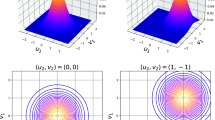Abstract
Quantum entanglement relies on the fact that pure quantum states are dispersive and often inseparable. Since pure classical states are dispersion-free they are always separable and cannot be entangled. However, entanglement is possible for epistemic, dispersive classical states. We show how such epistemic entanglement arises for epistemic states of classical dynamical systems based on phase space partitions that are not generating. We compute epistemically entangled states for two coupled harmonic oscillators.
Similar content being viewed by others
References
Allahverdyan, A.E., Khrennikov, A., Nieuwenhuizen, T.M.: Brownian entanglement. Phys. Rev. A 72, 032102 (2005)
Atmanspacher, H.: Quantum approaches to consciousness. In: Zalta, E.N. (ed.) Stanford Encyclopedia of Philosophy (2011). plato.stanford.edu/entries/qt-consciousness/
Atmanspacher, H., Primas, H.: Epistemic and ontic quantum realities. In: Castell, L., Ischebeck, O. (eds.) Time, Quantum and Information, pp. 301–321. Springer, Berlin (2003)
Atmanspacher, H., Filk, T., beim Graben, P.: Can classical epistemic states be entangled? In: Song, D., et al. (eds.) Quantum Interaction—QI 2011, pp. 105–115. Springer, Berlin (2011)
Bollt, E.M., Stanford, T., Lai, Y.C., Życzkowski, K.: What symbolic dynamics do we get with a misplaced partition? On the validity of threshold crossings analysis of chaotic time-series. Physica D 154, 259–286 (2001)
Bruza, P.D., Kitto, K., Nelson, D., McEvoy, C.L.: Is there something quantum-like about the human mental lexicon? J. Math. Psychol. 53, 362–377 (2009)
Cornfeld, I.P., Fomin, S.V., Sinai, Y.G.: Ergodic Theory. Springer, Berlin (1982)
Dvurečenskij, A., Pulmannová, S., Svozil, K.: Partition logics, orthoalgebras and automata. Helv. Phys. Acta 68, 407–428 (1995)
Einstein, A., Podolsky, B., Rosen, N.: Can quantum-mechanical description of physical reality be considered complete? Phys. Rev. 47(10), 777–780 (1935)
Foulis, D.J.: A half-century of quantum logic. What have we learned? In: Aerts, D. (ed.) Quantum Structures and the Nature of Reality, Einstein Meets Magritte: An Interdisciplinary Reflection on Science, Nature, Art, Human Action and Society, vol. 7, pp. 1–36. Kluwer Academic, Dordrecht (1999)
van Gelder, T.: The dynamical hypothesis in cognitive science. Brain Behav. Sci. 21, 1–14 (1998)
beim Graben, P., Atmanspacher, H.: Complementarity in classical dynamical systems. Found. Phys. 36, 291–306 (2006)
beim Graben, P., Atmanspacher, H.: Extending the philosophical significance of the idea of complementarity. In: Atmanspacher, H., Primas, H. (eds.) Recasting Reality. Wolfgang Pauli’s Philosophical Ideas and Contemporary Science, pp. 99–113. Springer, Berlin (2009)
Khrennikov, A.Y.: Representation of the Kolmogorov model having all distinguishing features of quantum probabilistic model. Phys. Lett. A 316(5), 279–296 (2003)
Khrennikov, A.Y.: Ubiquitous Quantum Structure: From Psychology to Finance. Springer, Berlin (2010)
Kolmogorov, A.N.: New metric invariant of transitive dynamical systems and endomorphisms of Lebesgue spaces. Dokl. Russ. Acad. Sci. 119, 861–864 (1958)
Lind, D.A., Marcus, B.: An Introduction to Symbolic Dynamics. Cambridge University Press, Cambridge (1995)
Pauli, W.: Die philosophische Bedeutung der Idee der Komplementarität. Experientia 6, 72–81 (1950). English translation: The philosophical significance of the notion of complementarity. In: Enz, C.P., von Meyenn, K. (eds.) Wolfgang Pauli. Writings on Physics and Philosophy, pp. 35–42 Springer, Berlin (1994)
Schrödinger, E.: Discussion of probability relations between separated systems. Proc. Camb. Philos. Soc. 31, 555–563 (1935)
Sinai, Y.G.: On the concept of entropy of a dynamical system. Dokl. Russ. Acad. Sci. 124, 768–771 (1959)
Svozil, K.: Logical equivalence between generalized urn models and finite automata. Int. J. Theor. Phys. 44, 745–754 (2005)
Walters, P.: Introduction to Ergodic Theory. Springer, Berlin (1981)
Wright, R.: Generalized urn models. Found. Phys. 20, 881–903 (1990)
Acknowledgements
This research was partly supported by the Franklin Fetzer Fund and by a DFG Heisenberg grant awarded to PbG (GR 3711/1-1).
Author information
Authors and Affiliations
Corresponding author
Rights and permissions
About this article
Cite this article
beim Graben, P., Filk, T. & Atmanspacher, H. Epistemic Entanglement due to Non-generating Partitions of Classical Dynamical Systems. Int J Theor Phys 52, 723–734 (2013). https://doi.org/10.1007/s10773-012-1381-6
Received:
Accepted:
Published:
Issue Date:
DOI: https://doi.org/10.1007/s10773-012-1381-6




